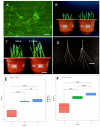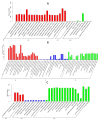Reprogramming of Fundamental miRNA and Gene Expression during the Barley- Piriformospora indica Interaction
- PMID: 36675845
- PMCID: PMC9865155
- DOI: 10.3390/jof9010024
Reprogramming of Fundamental miRNA and Gene Expression during the Barley- Piriformospora indica Interaction
Abstract
The interactions between plants and microorganisms, which are widely present in the microbial-dominated rhizosphere, have been studied. This association is highly beneficial to the organisms involved, as plants benefit soil microorganisms by providing them with metabolites, while microorganisms promote plant growth and development by promoting nutrient uptake and/or protecting the plant from biotic and abiotic stresses. Piriformospora indica, an endophytic fungus of Sebacinales, colonizes the roots of a wide range of host plants and establishes various benefits for the plants. In this work, an interaction between barley and the P. indica was established to elucidate microRNA (miRNA)-based regulatory changes in miRNA profiles and gene expression that occurred during the symbiosis. Growth promotion and vigorous root development were confirmed in barley colonized by P. indica. The genome-wide expression profile analysis of miRNAs in barley root showed that 7,798,928, 6,418,039 and 7,136,192 clean reads were obtained from the libraries of mock, 3 dai and 7 dai roots, respectively. Sequencing of the barley genome yielded in 81 novel miRNA and 450 differently expressed genes (DEGs). Additionally, 11, 24, 6 differentially expressed microRNAs (DEMs) in barley were found in the three comparison groups, including 3 dai vs. mock, 7 dai vs. mock and 7 dai vs. 3 dai, respectively. The predicted target genes of these miRNAs are mainly involved in transcription, cell division, auxin signal perception and transduction, photosynthesis and hormone stimulus. Transcriptome analysis of P. indica identified 667 and 594 differentially expressed genes (DEG) at 3 dai and 7 dai. Annotation and GO (Gene Ontology) analysis indicated that the DEGs with the greatest changes were concentrated in oxidoreductase activity, ion transmembrane transporter activity. It implies that reprogramming of fundamental miRNA and gene expression occurs both in barley and P. indica. Analysis of global changes in miRNA profiles of barley colonized with P. indica revealed that several putative endogenous barley miRNAs expressed upon colonization belonging to known micro RNA families involved in growth and developmental regulation.
Keywords: Piriformospora indica; RNA-seq; barley; miRNA; reprogramming; transcription factor.
Conflict of interest statement
The authors declare no conflict of interest.
Figures









Similar articles
-
Growth promotion-related miRNAs in Oncidium orchid roots colonized by the endophytic fungus Piriformospora indica.PLoS One. 2014 Jan 7;9(1):e84920. doi: 10.1371/journal.pone.0084920. eCollection 2014. PLoS One. 2014. PMID: 24409313 Free PMC article.
-
Genome-wide identification and characterization of long non-coding RNA in barley roots in response to Piriformospora indica colonization.Plant Sci. 2023 May;330:111666. doi: 10.1016/j.plantsci.2023.111666. Epub 2023 Feb 28. Plant Sci. 2023. PMID: 36858207
-
Proteomics study reveals the molecular mechanisms underlying water stress tolerance induced by Piriformospora indica in barley.J Proteomics. 2013 Dec 6;94:289-301. doi: 10.1016/j.jprot.2013.09.017. Epub 2013 Oct 11. J Proteomics. 2013. PMID: 24120527
-
Molecular mechanism underlying Piriformospora indica-mediated plant improvement/protection for sustainable agriculture.Acta Biochim Biophys Sin (Shanghai). 2019 Mar 1;51(3):229-242. doi: 10.1093/abbs/gmz004. Acta Biochim Biophys Sin (Shanghai). 2019. PMID: 30883651 Review.
-
Role of Phytohormones in Piriformospora indica-Induced Growth Promotion and Stress Tolerance in Plants: More Questions Than Answers.Front Microbiol. 2018 Jul 31;9:1646. doi: 10.3389/fmicb.2018.01646. eCollection 2018. Front Microbiol. 2018. PMID: 30140257 Free PMC article. Review.
Cited by
-
Research Progress of Piriformospora indica in Improving Plant Growth and Stress Resistance to Plant.J Fungi (Basel). 2023 Sep 26;9(10):965. doi: 10.3390/jof9100965. J Fungi (Basel). 2023. PMID: 37888222 Free PMC article. Review.
-
Detection of closely linked QTLs and candidate genes controlling germination indices in response to drought and salinity stresses in barley.Sci Rep. 2024 Jul 8;14(1):15656. doi: 10.1038/s41598-024-66452-9. Sci Rep. 2024. PMID: 38977885 Free PMC article.
-
The Impact of Piriformospora indica on plant heat and drought tolerance.Front Plant Sci. 2024 Dec 6;15:1479561. doi: 10.3389/fpls.2024.1479561. eCollection 2024. Front Plant Sci. 2024. PMID: 39711589 Free PMC article.
-
Identification and Characterization of a Plant Endophytic Fungus Paraphaosphaeria sp. JRF11 and Its Growth-Promoting Effects.J Fungi (Basel). 2024 Jan 31;10(2):120. doi: 10.3390/jof10020120. J Fungi (Basel). 2024. PMID: 38392792 Free PMC article.
References
-
- Deshmukh S., Huckelhoven R., Schäfer P., Imani J., Sharma M., Weiss M., Waller F., Kogel K.-H. The root endophytic fungus Piriformospora indica requires host cell death for proliferation during mutualistic symbiosis with barley. Proc. Natl. Acad. Sci. USA. 2006;103:18450–18457. doi: 10.1073/pnas.0605697103. - DOI - PMC - PubMed
Grants and funding
LinkOut - more resources
Full Text Sources

